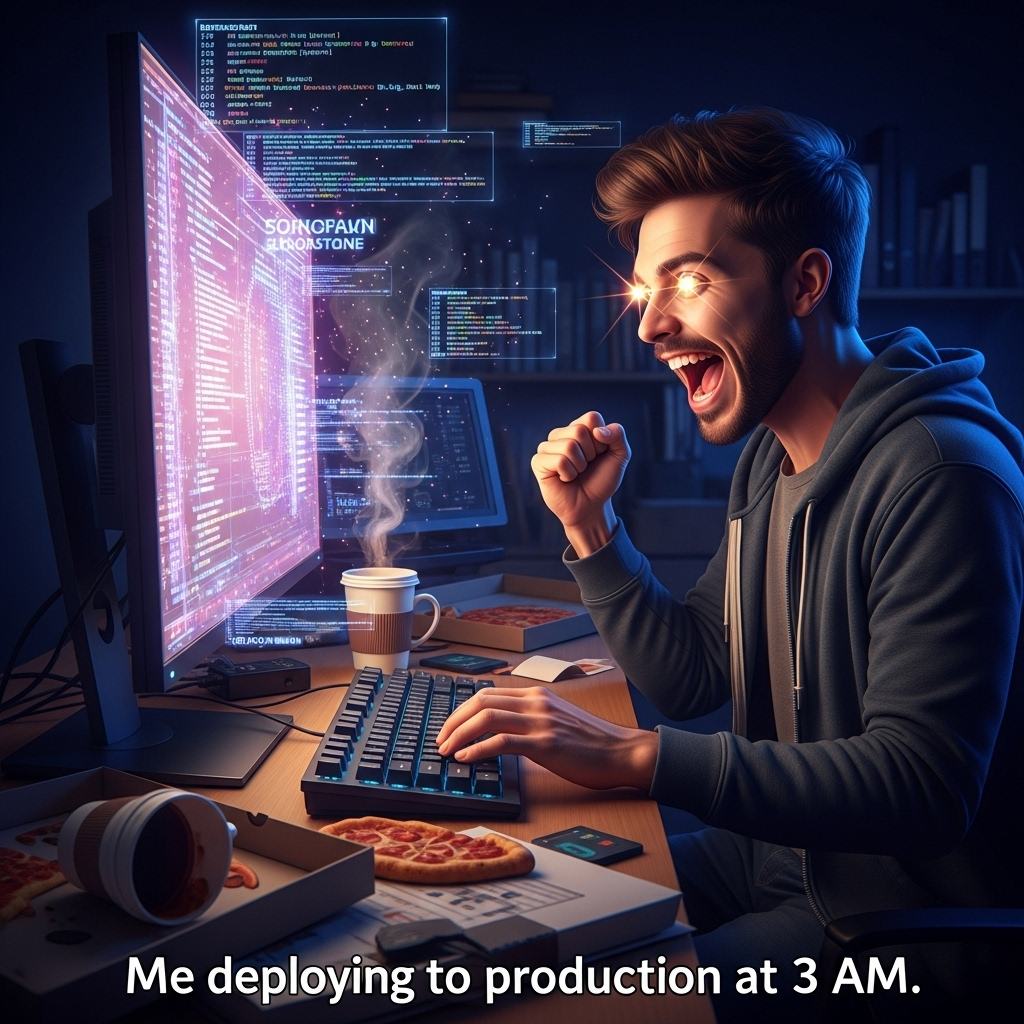The Labyrinth of Quantization: My Descent into Madness and Revelation | by FDR_Alex | Oct, 2025

Prologue: The Question That Started It All
It all began with a single question that haunted me at 3 AM: What if I could bend the laws of neural compression? I was staring at my screen, wrestling with a 7-billion-parameter language model that stubbornly refused to fit on anything smaller than a massive server rack. The electricity bill was skyrocketing — enough to fund a small startup — and the inference latency turned real-time applications into nothing more than a pipe dream.
But deep in the mathematics, amid the elegant symmetries of linear algebra and information theory, I knew there had to be a way. A secret door. A hidden passage that could shrink these digital giants into something manageable, deployable, even revolutionary. The AI chatbots promised miracles: 10×, 20×, even 50× compression with “minimal quality loss.” Gemini, GPT, and Grok all spoke in reverent tones about “lossless” quantization, making AI accessible to everyone, everywhere.
I believed them. That was my first mistake.
For three weeks, I tumbled down a rabbit hole. My poor computer — a GTX 1070 that Gemini had mocked as a “typewriter” — whirred in protest, its fans roaring like a jet engine, its 8 cores maxed out at 100%, and its 16 GB of RAM exhausted, swapping data relentlessly. I coded scripts, built C++ kernels, and ran benchmark after benchmark. Life faded away; I worked until dawn, and even in sleep, my mind raced with brainstorms and error messages flickering like ghosts behind my eyelids. My machine never rested, grinding through hundreds of thousands of weights, ready to greet me at dawn with either a breakthrough or another cryptic failure.
#### Act I: The Symphony That Fell Out of Tune
It started with what felt like a divine spark. I was reading about carry propagation in ancient computer architectures — how adding numbers could trigger a cascade, each digit influencing the next like falling dominoes. Then, lightning struck: What if neural weights weren’t just isolated values, but a living orchestra where each number influenced its neighbors through integer arithmetic?
I envisioned a vast network of weights as a dynamic system. Quantizing one would propagate a “carry” to the others, creating implicit dependencies that slashed redundancy. Like a jazz ensemble where every musician responds to the others, turning chaos into harmony.
I called it Integer Carry Weights — ICW — and it was born from that vision. For five feverish days, I coded prototypes and tested them on toy models. The early results were intoxicating: compression ratios that defied logic, quality metrics that held strong. My Python prototype hummed with promise, and I felt like I’d discovered a new element in the periodic table of compression algorithms.
The benchmarks looked golden. The theory was elegant. I could already picture the Medium posts, conference talks, and GitHub stars rolling in.
Then I tried scaling it up. The symphony turned to cacophony.
GPUs, the backbone of modern ML, have no idea what “integer carry propagation as a compression primitive” even means. They’re designed for parallel operations on standard data types. My beautiful cascade forced everything into sequential processing — each carry waiting for the last to finish.
I plunged into CUDA, crafting custom kernels from scratch. Weeks blurred into months. The code grew tangled and fragile. Multi-threaded inference brought race conditions — weights clashing in unpredictable ways, corruption rippling through layers.
And then the brutal truth hit: The patterns I’d “discovered” were just artifacts of my test cases. On real, diverse models, the emergent structure vanished. The method demanded hardware that didn’t exist — custom ASICs, specialized accelerators. A parallel universe where GPUs had evolved differently.
ICW wasn’t a breakthrough. It was a beautiful delusion, untethered from silicon’s harsh reality.
Status: Abandoned. No measurable results. Custom hardware required.
The crash from that high crushed me. But failure sparked desperation, and desperation fueled creativity. What if the problem wasn’t the approach, but the space I was working in?
#### Act II: The Alchemist’s Dream That Turned to Dust
From ICW’s ashes rose a new idea: orthogonal transformations. The Hadamard transform felt almost magical — a square matrix of +1s and -1s, perfectly orthogonal, perfectly balanced. Multiply it by a vector, and information spreads evenly, like light through a prism exploding into a spectrum.
In theory, quantization errors would distribute uniformly, canceling out through symmetries. No single weight would bear the full burden; everyone shared it.
I dubbed it Hadamard-Aware Block Quantization — HABQ++ — and it promised to tame chaos into order. Papers boasted SNR values over 50 dB — near-impossible levels. I coded the transforms, implemented adaptive blocking, and optimized every step.
Initial tests on small matrices were euphoric. The numbers didn’t just meet expectations; they obliterated them.
For seventy-two glorious hours, I thought I’d cracked it.
Then scaling slammed into me like a freight train: O(n²) complexity. Double the dimensions, and costs quadruple. For the massive weight matrices in LLMs, this wasn’t expensive — it was catastrophic.
GPUs offered no native support for Hadamard transforms. No acceleration, no optimized kernels. Everything fell back to raw matrix multiplications, while tensor cores idled.
I tried it all: decomposing transforms, caching results, approximate matrices, rewriting code six ways. Nothing. The method clashed with how hardware thinks. Branch predictions failed, cache thrashing slowed everything to a crawl. Sparse weights spawned NaNs that spread like a virus.
Status: Failed. Theory beautiful. Practice catastrophic. No hardware support.
The oasis was a mirage. I watched it fade, feeling something inside me break. Maybe I was chasing the wrong kind of beauty.
#### Act III: The Mosaic That Shattered Under Pressure
Humbled, I turned to locality. Instead of global tricks, I’d treat each weight matrix like a mosaic — break it into tiles, quantize each with its own codebook, use residuals to fix errors. Build quality from the ground up.
Local Product Quantization with Residuals — Local PQ-R — felt like the perfect balance. Not too wild like ICW, not too complex like HABQ++. Just solid engineering.
I benchmarked a mid-sized layer, and the results stopped my heart:
– up_proj layer: Linear INT8 baseline at 27.6 dB, GGML Q8_0 at 45.3 dB, but Local PQ-R 4+4 hit 61.5 dB.
61.5 decibels. Not an increment — a domination. Similar across gate_proj and q_proj. Beating industry standards by over 16 dB, slashing errors by orders of magnitude.
I stared at the numbers for an hour, reran tests, triple-checked code. They held. This was it — the breakthrough.
Trade-offs looked ideal: At block size 32, SNR peaked at 61.5 dB with good compression. Larger blocks traded SNR for better ratios, a smooth curve. An engineer’s dream.
I refined it for two weeks, tuning for production. It purred on real LLMs. The mosaic was flawless.
Then production scaling hit. Computational costs exploded. K-means clustering per block was O(k²) — tens of thousands of blocks in a 7B model meant hours on high-end hardware.
Worse, my assumptions crumbled. Weights in blocks weren’t always correlated. Attention layers were chaotic. Some blocks shone; others noise. No predictability.
Cache issues arose, false sharing eroded speedups. Fixed-precision hardware made residuals inefficient.
Status: Partial success and useless. SNR 61+ dB. Compression limited. O(k²) clustering impractical at scale.
The Ferrari I’d built could only race on perfect roads. Beautiful, powerful, useless. What if I stopped chasing perfection and settled for “good enough”?
#### Act IV: The Pragmatist’s Compromise That Felt Like Surrender
Exhausted, I rebuilt from scratch with a new mantra: pragmatism over perfection.
Adaptive Filtered Delta Quantization — AFDQ — wasn’t flashy. It evolved standard quantization, adding adaptive delta corrections based on layer sensitivity. Like battlefield triage: Fix what matters, accept losses elsewhere.
Implementation: Two days. Testing: Three.
Results:
– SNR: 38–42 dB across architectures
– Compression: 6–8×
– Speedup: 3–4× on consumer GPUs
– Status: Might be deployable
For the first time in weeks, something worked reliably. It cut costs, sped inference, solved real problems.
But it felt hollow. AFDQ lived in the middle ground. Push to 16× or 4-bit, and quality tanked. Heuristics were fragile, architecture-specific. A stepping stone, not the goal.
Status: Production-ready, but not revolutionary. SNR 38–42 dB. Compression 6–8×. But not the revolution I craved.
Why did success taste like defeat?
#### Act V: Wandering the Wilderness of Wild Ideas
Restless, I veered back to speculation. What if I treated neural weights like 3D scenes? Neural Style Transfer for images, but for weights — decompose into style and content, compress separately like game textures with LOD and mip-mapping.
It was intoxicating: Graphics fused with ML, custom kernels, decomposition pipelines. Felt like true innovation.
Reality: Decomposition overheads ballooned. Weights lacked spatial coherence. No hardware support. Industry ignored it.
Status: Abandoned. Too complex. No viability.
Nearly four weeks gone. Zero value.
Burned out, I simplified: Zero-based Encoding — piecewise linear approximation. Like JPEG for parameters.
Results: SNR ~25–30 dB. In a 40+ dB world, it was obsolete. Outliers wrecked assumptions. More segments? More overhead.
Status: Inadequate. SNR too low.
Simplicity without smarts is just failure.
#### Act VI: The Survivors That Emerged from the Wreckage
Scalar Quantization with Outlier Encoding — SQ-OE — came from quiet pragmatism. Simple: Quantize 95% standardly, handle 5% outliers at higher precision with indices.
No frills. Just facing power-law distributions head-on.
Results:
– SNR: ~39 dB
– Compression: ~4.3×
– Status: Stable
Outlier overhead: 2–5%. Robust across models, fast on hardware.
SQ-OE didn’t excel anywhere but was reliable — the unglamorous hero.
One last synthesis: Product Quantization with Residual Core — PQR Core. Global codebook, product efficiency, residual quality.
Results on lm_head.weight:
– SNR: 33.20 dB
– Compression: 2.00×
– Time: 185.38 seconds
Status: Failed. Too slow, weak compression, marginal gains.
It buckled under ambition — theory over reality.
#### Epilogue: What I Learned in the Labyrinth’s Depths
One month. Nine methods. Two survivors.
The scoreboard:
✅ SQ-OE: SNR 39 dB, 4.3× compression
✅ AFDQ: SNR 38–42 dB, 6–8× compression
❌ Local PQ-R: SNR 61+ dB, but impractical
❌ PQR Core: SNR 33 dB, 2×, too slow
❌ ZbE: SNR 25–30 dB — inadequate
❌ HABQ++: O(n²), no support
❌ ICW: Custom hardware needed
❌ NST/RT-NST: No viability
The labyrinth scarred me with truths:
1. Hardware rules all. Perfect math means nothing without GPU buy-in.
2. Assumptions are debts reality collects.
3. Complexity invites failure.
4. Shipping trumps perfection.
5. The field evolves faster than you can perfect.
Breakthroughs aren’t glamorous. They come from survivors that respect trade-offs and deploy.
SQ-OE and AFDQ weren’t my wildest dreams, but they worked. Local PQ-R was superior technically, but scalability killed it. In production, that wins every time.
The maze goes on: Mixed-precision, training-aware quantization, pruning hybrids, even quantum-inspired stuff.
But now I approach with skepticism, probing constraints first. Persistence beats brilliance; incremental wins over revolutions. True innovation? Spotting what survives reality.
If you’re entering your own labyrinth:
– Test hardware early.
– Challenge assumptions.
– Ship something.
– Honor the practical.
– Know when to stop.
The whispers persist: “What if we could…?” But now, I listen wisely before leaping.
— –
**About Me:** A reformed optimist, a battle-hardened ML researcher who learned reality ignores elegant theories. Now, I ship practical solutions while dreamers chase shadows.

